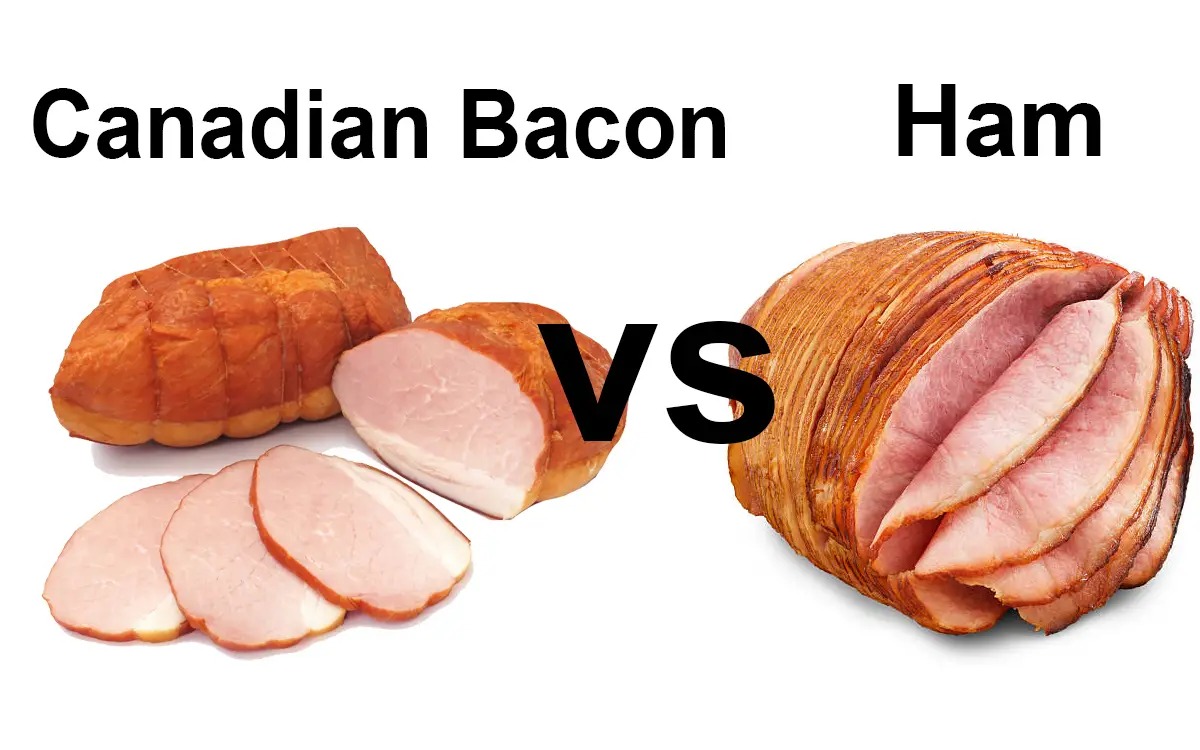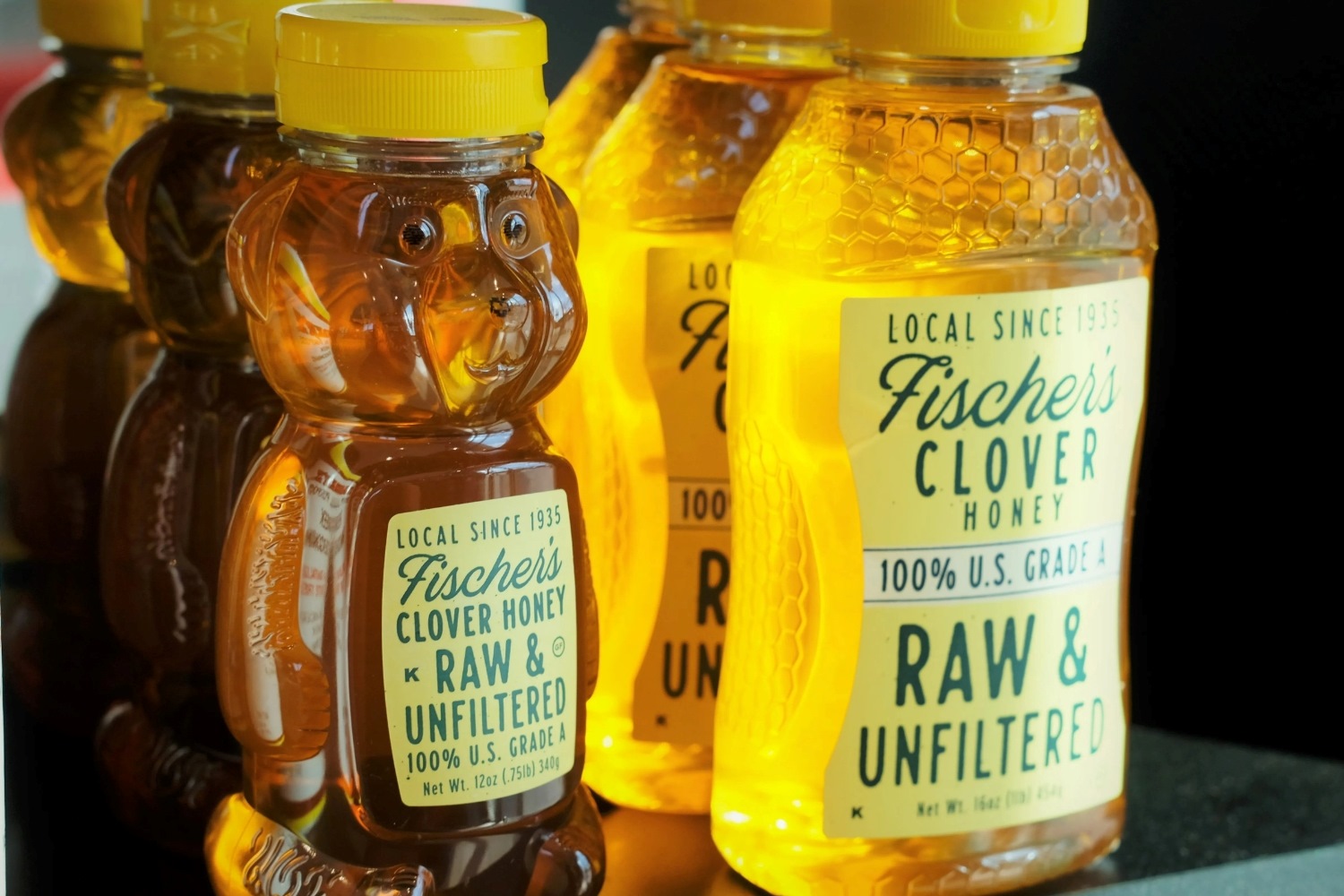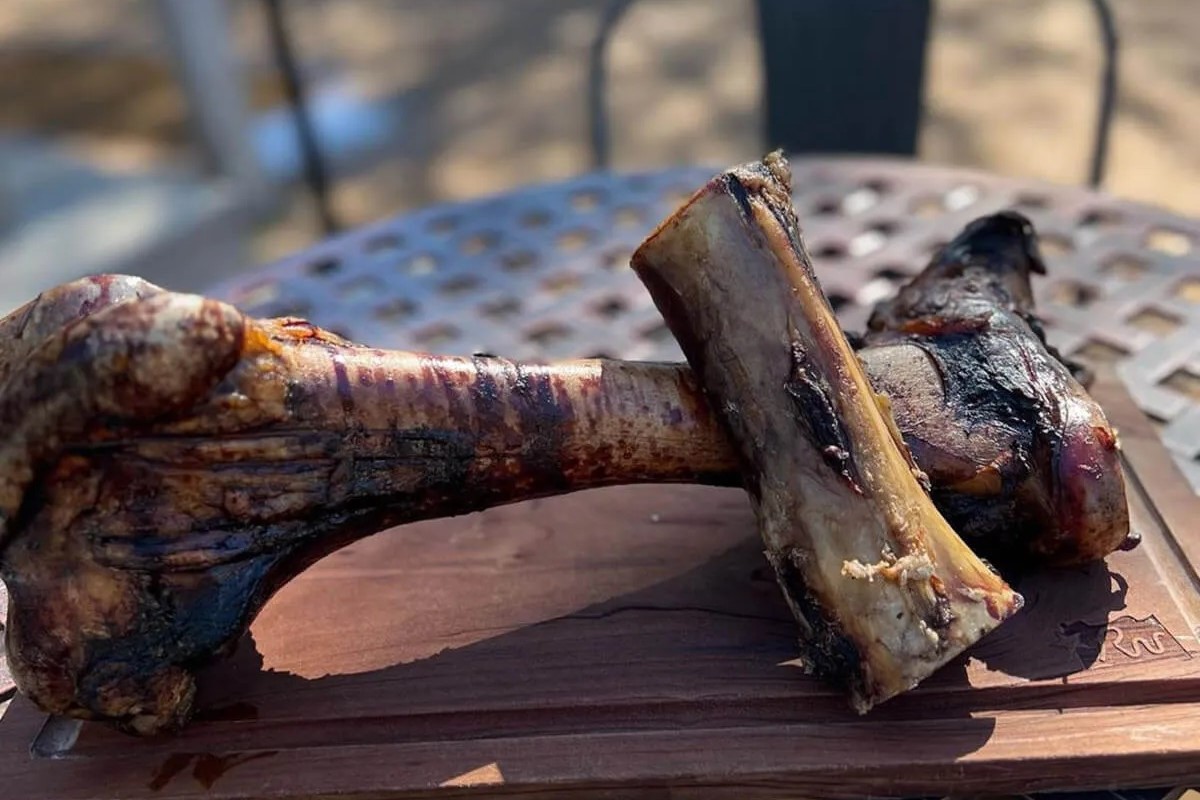Home>Food and Cooking>The Surprising Truth About Canadian Bacon Vs. English Ham


Food and Cooking
The Surprising Truth About Canadian Bacon Vs. English Ham
Modified: March 3, 2024
Discover the key differences between Canadian bacon and English ham in this insightful guide to food and cooking. Uncover the surprising truth behind these two beloved meats.
(Many of the links in this article redirect to a specific reviewed product. Your purchase of these products through affiliate links helps to generate commission for Noodls.com, at no extra cost. Learn more)
Table of Contents
Introduction
When it comes to the world of cured meats, Canadian bacon and English ham stand out as two iconic delicacies with rich culinary histories. These delectable meats have captured the hearts and taste buds of food enthusiasts around the globe, each offering a distinct flavor profile and culinary versatility. Despite their similar appearances, Canadian bacon and English ham differ significantly in terms of their origin, preparation, and usage. In this comprehensive comparison, we will delve into the surprising truths behind these beloved meats, exploring their unique characteristics, nutritional profiles, culinary applications, and regional influences. By uncovering the nuances of Canadian bacon and English ham, we aim to provide a deeper understanding of these savory delights and celebrate the diverse traditions that have shaped their culinary identities. So, let's embark on a flavorful journey to unravel the captivating tale of Canadian bacon versus English ham.
What is Canadian Bacon?
Canadian bacon, also known as "back bacon," is a beloved pork product that boasts a unique flavor and texture. Unlike traditional bacon, which is derived from the pork belly, Canadian bacon is crafted from the lean, tender eye of the pork loin. This results in a meaty and slightly sweet taste, setting it apart from its fatty and smoky counterpart.
The preparation of Canadian bacon involves curing the pork loin in a seasoned brine, often infused with a blend of savory spices such as black pepper, coriander, and maple for a touch of sweetness. After the curing process, the meat is typically smoked to impart a delicate smokiness that enhances its overall flavor profile.
Canadian bacon is characterized by its round, compact shape and uniform pink hue, making it easily distinguishable from other pork products. Its lean yet succulent texture makes it a versatile ingredient in various culinary applications, from breakfast dishes to gourmet sandwiches and salads.
In Canada, this delectable meat is a staple in the national cuisine, often enjoyed as a key component of the classic "peameal bacon sandwich." The term "peameal bacon" originates from the traditional practice of rolling the cured pork loin in ground yellow peas, a historical preservation method that has evolved into a distinctive culinary tradition.
Beyond Canada, Canadian bacon has gained popularity in international cuisines, adding a touch of sophistication and savory goodness to an array of dishes. Its mild yet flavorful profile makes it a versatile ingredient, lending itself to creative interpretations in both home kitchens and professional culinary settings.
In essence, Canadian bacon embodies a harmonious blend of savory, slightly sweet, and smoky notes, making it a beloved delicacy with a rich heritage and a timeless place on the global culinary stage.
What is English Ham?
English ham, renowned for its rich flavor and succulent texture, holds a revered status in the realm of cured meats. Also referred to as "York ham" or "country ham," this traditional British delicacy is crafted from the hind leg of a pig, resulting in a generous marbling of fat and a robust, savory taste.
The process of preparing English ham involves curing the hind leg of the pig with a blend of salt, sugar, and aromatic spices, such as cloves, juniper berries, and bay leaves. This meticulous curing process infuses the meat with a complex depth of flavor, while the natural marbling of fat contributes to its tender and juicy consistency.
After the curing phase, the ham is often air-dried or smoked, allowing the flavors to mature and intensify. The duration of the aging process can vary, with some hams undergoing prolonged curing periods to achieve a more pronounced flavor profile.
English ham is characterized by its deep, rosy-pink color and a rich, savory aroma that reflects the careful craftsmanship behind its creation. Its texture is both firm and succulent, offering a satisfying bite that gives way to a melt-in-your-mouth tenderness.
In British culinary traditions, English ham holds a prominent place, featuring in a myriad of classic dishes such as ploughman's lunch, ham and pea soup, and the iconic ham sandwich. Its versatility extends beyond traditional British fare, as it serves as a prized ingredient in gourmet salads, quiches, and charcuterie boards around the world.
The regional variations in the production and seasoning of English ham contribute to its diverse flavor profiles, with different regions showcasing their unique techniques and regional influences. Whether enjoyed as part of a hearty English breakfast or incorporated into elegant culinary creations, English ham continues to captivate palates with its timeless appeal and artisanal craftsmanship.
In essence, English ham represents a harmonious fusion of robust flavors, tender textures, and time-honored traditions, making it a cherished cornerstone of British gastronomy and a celebrated delicacy on the global culinary stage.
Nutritional Comparison
When comparing the nutritional profiles of Canadian bacon and English ham, several key factors come into play, offering insights into their respective health benefits and culinary applications. Both Canadian bacon and English ham are excellent sources of high-quality protein, essential vitamins, and minerals, making them valuable additions to a balanced diet.
Canadian bacon, derived from the lean eye of the pork loin, is notably lower in fat compared to traditional bacon, offering a leaner alternative for individuals seeking a lighter yet satisfying protein option. Its moderate fat content contributes to a favorable balance of macronutrients, making it a popular choice for health-conscious consumers. Additionally, the curing process of Canadian bacon introduces a nuanced blend of seasonings, enhancing its flavor without relying heavily on added fats or sodium.
On the other hand, English ham, with its generous marbling of fat, provides a richer source of dietary fats and calories. While the higher fat content contributes to its succulent texture and robust flavor, it is essential to consume English ham in moderation as part of a well-rounded diet. The natural fats present in English ham contribute to its mouthwatering taste and tender consistency, adding depth and complexity to its overall nutritional profile.
In terms of protein content, both Canadian bacon and English ham offer a substantial amount of high-quality protein, essential for muscle maintenance, repair, and overall bodily functions. This makes them valuable options for individuals following high-protein diets, athletes seeking muscle recovery support, and those aiming to maintain a satiating and nourishing meal plan.
Furthermore, both Canadian bacon and English ham contain essential vitamins and minerals, including B vitamins, phosphorus, zinc, and selenium, which play crucial roles in supporting overall health and well-being. These nutrients contribute to energy metabolism, immune function, and cellular processes, underscoring the nutritional value of these cured meats beyond their protein content.
In summary, the nutritional comparison between Canadian bacon and English ham reveals distinct characteristics that cater to diverse dietary preferences and nutritional needs. Whether seeking a lean, flavorful protein option or indulging in the rich, savory notes of a well-marbled delicacy, both Canadian bacon and English ham offer unique nutritional advantages, adding depth and variety to the culinary landscape.
Taste and Texture
The distinction between Canadian bacon and English ham extends beyond their geographical origins and culinary traditions, encompassing their taste and texture, which play pivotal roles in shaping their culinary appeal.
Canadian bacon, originating from the lean eye of the pork loin, offers a unique interplay of flavors and textures. Its lean composition contributes to a meaty yet tender texture, striking a delicate balance that distinguishes it from traditional bacon. The curing process infuses Canadian bacon with a subtle sweetness, complemented by a hint of smokiness from the smoking phase. This results in a harmonious fusion of savory, slightly sweet, and smoky notes, creating a flavor profile that is both nuanced and versatile. The texture of Canadian bacon is notably lean and succulent, with a satisfying bite that gives way to a tender consistency, making it an ideal choice for those seeking a lighter yet satisfying protein option.
In contrast, English ham, crafted from the hind leg of the pig, embodies a robust and savory taste accompanied by a rich, succulent texture. The natural marbling of fat within the ham contributes to its tender and juicy consistency, enhancing its overall mouthfeel and depth of flavor. The curing process, often infused with a blend of aromatic spices, imparts a complex and savory taste that reflects the artisanal craftsmanship behind its creation. The texture of English ham is both firm and succulent, offering a satisfying bite that gives way to a melt-in-your-mouth tenderness, showcasing the meticulous curing and aging process that defines its culinary identity.
The taste and texture of Canadian bacon and English ham are emblematic of the diverse culinary traditions and regional influences that have shaped their respective profiles. Whether savoring the lean, slightly sweet notes of Canadian bacon or indulging in the robust, savory richness of English ham, both delicacies offer a sensorial journey that celebrates the artistry and heritage of cured meats.
In essence, the taste and texture of Canadian bacon and English ham capture the essence of their culinary allure, inviting enthusiasts to explore the nuanced flavors and textures that define these timeless delicacies.
Cooking and Culinary Uses
The versatility of Canadian bacon and English ham extends far beyond their traditional roles as breakfast staples, offering a wealth of culinary possibilities that cater to diverse palates and culinary preferences. From breakfast classics to gourmet creations, these cured meats serve as culinary canvases for a myriad of delectable dishes, showcasing their unique flavors and textures in creative and satisfying ways.
Canadian Bacon:
Canadian bacon's lean yet flavorful profile makes it a versatile ingredient in a wide range of culinary applications. When it comes to breakfast, Canadian bacon shines as a key component in the iconic Eggs Benedict, adding a savory and meaty layer to the indulgent dish. Its round shape and uniform texture make it a perfect fit for breakfast sandwiches, providing a wholesome and satisfying protein boost. In addition, Canadian bacon's mild yet distinctive flavor pairs beautifully with eggs, making it a welcome addition to frittatas, omelets, and breakfast burritos.
Beyond breakfast, Canadian bacon lends itself to creative interpretations in savory entrées and appetizers. Its meaty texture and subtle sweetness make it an excellent topping for pizzas, adding a gourmet touch to classic and artisanal varieties. When incorporated into salads, quiches, and savory tarts, Canadian bacon infuses a burst of flavor and protein, elevating these dishes with its unique culinary presence. Its versatility extends to pasta dishes, where it can be diced and sautéed to add depth to creamy carbonara or tossed with vibrant vegetables in a flavorful primavera.
English Ham:
The rich, savory notes and succulent texture of English ham make it a prized ingredient in traditional British fare and gourmet culinary creations alike. In British cuisine, English ham takes center stage in the beloved ploughman's lunch, served alongside crusty bread, pickles, and chutney for a satisfying and rustic meal. Its robust flavor and tender consistency make it an ideal filling for sandwiches, imparting a hearty and savory element to classic combinations such as ham and cheese or ham and mustard.
English ham's culinary versatility extends to elegant entrées and appetizers, where its depth of flavor and tender texture shine. When used in quiches and savory pies, English ham adds a savory richness that complements creamy fillings and flaky pastry, creating a comforting and indulgent dish. In charcuterie boards and antipasto platters, thin slices of English ham offer a savory and visually appealing component, pairing beautifully with an array of cheeses, fruits, and artisanal bread.
In summary, both Canadian bacon and English ham offer a wealth of culinary possibilities, from breakfast indulgences to gourmet creations. Their distinct flavors and textures elevate a diverse array of dishes, showcasing the artistry and versatility of these beloved cured meats in the culinary world. Whether enjoyed in classic recipes or innovative culinary creations, Canadian bacon and English ham continue to inspire culinary enthusiasts with their timeless appeal and culinary adaptability.
Cultural and Regional Differences
The cultural and regional differences surrounding Canadian bacon and English ham reflect the diverse culinary traditions and historical influences that have shaped these iconic cured meats. Originating from distinct geographical regions with unique culinary practices, these delicacies embody the rich tapestry of traditions and flavors that define their cultural significance.
Canadian Bacon:
In Canada, the affinity for Canadian bacon transcends mere culinary preference, representing a cultural emblem deeply rooted in the nation's culinary heritage. The term "peameal bacon," synonymous with Canadian bacon, pays homage to the historical practice of rolling cured pork loin in ground yellow peas, a preservation method that has evolved into a quintessential Canadian tradition. This unique preparation method reflects the resourcefulness and ingenuity of early Canadian settlers, highlighting the intersection of culinary innovation and practicality in shaping the country's gastronomic identity.
Beyond its historical roots, Canadian bacon holds a cherished place in Canadian cuisine, featuring prominently in classic dishes such as the peameal bacon sandwich. This beloved creation, consisting of thinly sliced Canadian bacon nestled between a soft bun, embodies the essence of Canadian comfort food, offering a harmonious blend of savory, slightly sweet, and smoky flavors that resonate with generations of Canadians.
English Ham:
In the United Kingdom, the tradition of curing and enjoying ham holds deep cultural significance, with regional variations and time-honored techniques contributing to the diverse landscape of English ham. The term "York ham" and "country ham" reflect the regional nuances and proud culinary heritage associated with English ham, underscoring its role as a symbol of British gastronomy.
English ham's presence in British culinary traditions is evident in the enduring popularity of dishes such as the ploughman's lunch, where thick slices of ham are served alongside crusty bread, pickles, and chutney, embodying the rustic and wholesome essence of traditional British fare. The art of curing and aging ham in the UK reflects a legacy of craftsmanship and expertise passed down through generations, preserving the time-honored traditions that define the cultural significance of English ham.
Regional Influences:
The regional influences on Canadian bacon and English ham extend beyond their countries of origin, with global culinary landscapes embracing and adapting these delicacies to suit diverse palates and preferences. In North America, Canadian bacon has found a place in popular fast-food breakfast offerings, showcasing its versatility and appeal to a wide audience. Similarly, English ham's presence in gourmet charcuterie boards and upscale culinary establishments reflects its enduring allure and adaptability in contemporary gastronomy.
The cultural and regional differences surrounding Canadian bacon and English ham serve as a testament to the enduring legacy of cured meats in shaping culinary identities and traditions. As these iconic delicacies continue to captivate palates around the world, their cultural significance remains a testament to the timeless artistry and culinary heritage that define the global appreciation for these beloved cured meats.
Conclusion
In conclusion, the captivating tale of Canadian bacon versus English ham unveils a rich tapestry of culinary traditions, regional influences, and timeless flavors that have shaped these iconic cured meats. From the lean and subtly sweet profile of Canadian bacon to the robust and savory richness of English ham, each delicacy offers a sensorial journey that celebrates the artistry and heritage of cured meats.
The distinct characteristics of Canadian bacon and English ham extend beyond their geographical origins, reflecting the diverse culinary landscapes and cultural legacies that have elevated them to culinary stardom. Whether enjoyed in classic recipes deeply rooted in Canadian and British traditions or incorporated into innovative culinary creations around the world, these cured meats continue to inspire culinary enthusiasts with their timeless appeal and culinary adaptability.
The nutritional comparison between Canadian bacon and English ham underscores their unique attributes, offering valuable insights into their health benefits and culinary applications. While Canadian bacon provides a lean yet flavorful protein option, English ham presents a rich source of savory indulgence, catering to diverse dietary preferences and nutritional needs.
The taste, texture, and culinary uses of Canadian bacon and English ham showcase their versatility and adaptability in a myriad of dishes, from breakfast classics to gourmet creations. Their nuanced flavors and tender textures elevate a diverse array of culinary creations, inviting enthusiasts to explore the artistry and versatility of these beloved cured meats.
The cultural and regional differences surrounding Canadian bacon and English ham reflect the diverse culinary traditions and historical influences that have shaped these iconic delicacies. From Canada's proud culinary heritage embodied in the peameal bacon sandwich to the enduring legacy of craftsmanship and expertise associated with English ham in the United Kingdom, these cured meats stand as cultural emblems deeply rooted in culinary traditions.
As Canadian bacon and English ham continue to captivate palates around the world, their cultural significance remains a testament to the timeless artistry and culinary heritage that define the global appreciation for these beloved cured meats. Whether relishing the lean, slightly sweet notes of Canadian bacon or savoring the robust, savory richness of English ham, these iconic delicacies invite enthusiasts to embark on a flavorful journey that celebrates the diverse traditions and flavors that define the culinary world.













